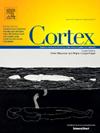主观认知衰退个体的长期联想记忆和空间模式分离障碍:神经心理学和内侧颞叶亚区容量分析
IF 3.3
2区 心理学
Q1 BEHAVIORAL SCIENCES
引用次数: 0
摘要
主观认知能力下降(SCD)被认为是阿尔茨海默病(AD)痴呆的潜在临床前阶段。本研究旨在探讨SCD在高要求记忆任务中是否存在客观障碍,以及它们与内侧颞叶(MTL)容量的可能关联。比较了31名SCD患者和29名无认知衰退忧虑的健康老年人在面孔-名称-职业联想记忆和空间模式分离两项实验任务上的表现。评估了这些测试对认知状态分类的诊断能力。此外,20例SCD和19例HC亚组接受了3T-MRI检查。计算并比较两组海马亚区和MTL内周围皮层的体积。最后,对脑容量与实验任务表现之间可能存在的关联进行了评估。传统的神经心理测试没有显示组间差异,但scd在实验任务上的得分明显低于hc。这些措施还以良好的总体准确性正确地分类了组成员。体积数据显示,特定海马亚区(特别是CA1和齿状回)和周围皮层(特别是嗅内和嗅周皮层)在组间存在显著差异。此外,实验任务得分较低与特定MTL子区域(特别是CA1和周围皮层)的体积减少显著相关。这些发现提供了SCD中联想记忆的客观记忆障碍与空间模式分离和已知主要易受AD神经病理影响的特定MTL子区域体积减少之间的关联的第一个证据。本文章由计算机程序翻译,如有差异,请以英文原文为准。
Long-term associative memory and spatial pattern separation impairments in individuals with subjective cognitive decline: A neuropsychological and medial temporal lobe subregions volumetric analysis
Subjective cognitive decline (SCD) has been proposed as a potential preclinical stage of Alzheimer's disease (AD) dementia. This study aimed to investigate whether objective impairments could be identified in SCD on highly demanding memory tasks and their possible associations with medial temporal lobe (MTL) volumes. The performance of 31 individuals with SCD and 29 healthy elderly with no worries of cognitive decline (HC) was compared on two experimental tasks assessing respectively face–name-occupation associative memory and spatial pattern separation. The diagnostic power of these tests in classifying cognitive status was assessed. In addition, a sub-group of 20 SCD and 19 HC underwent a 3T-MRI. Volumes of individual hippocampal subfields and surrounding cortices within the MTL were calculated and compared between the two groups. Finally, possible associations between brain volumes and performance on experimental tasks were evaluated. While traditional neuropsychological tests showed no significant between-group differences, SCDs obtained significantly lower scores than HCs on experimental tasks. These measures also correctly classified group membership with good overall accuracy. Volumetric data revealed significant between-group differences in specific hippocampal subfields (particularly CA1 and dentate gyrus) and surrounding cortices (particularly entorhinal and perirhinal cortices). Furthermore, lower scores on experimental tasks significantly correlated with reduced volumes in specific MTL sub-regions (particularly CA1 and perirhinal cortices). These findings provide the first evidence in SCD of an association between objective memory impairments in associative memory and spatial pattern separation and volume reductions in specific MTL sub-regions known to be primarily vulnerable to AD neuropathology.
求助全文
通过发布文献求助,成功后即可免费获取论文全文。
去求助
来源期刊

Cortex
医学-行为科学
CiteScore
7.00
自引率
5.60%
发文量
250
审稿时长
74 days
期刊介绍:
CORTEX is an international journal devoted to the study of cognition and of the relationship between the nervous system and mental processes, particularly as these are reflected in the behaviour of patients with acquired brain lesions, normal volunteers, children with typical and atypical development, and in the activation of brain regions and systems as recorded by functional neuroimaging techniques. It was founded in 1964 by Ennio De Renzi.
 求助内容:
求助内容: 应助结果提醒方式:
应助结果提醒方式:


